Cultural Heritage Color Regeneration: Interactive Genetic Algorithm Optimization Based on Color Network and Harmony Models
Abstract
1. Introduction
- Enhancing the cultural adaptability of color-matching—Extracting color features specific to cultural contexts based on the color network model to construct an initial color gene set that aligns with traditional color imagery;
- Improving the automation of color evaluation—Employing a color harmony prediction model to partially replace manual evaluation, thereby reducing user fatigue and enhancing optimization efficiency;
- Developing an efficient color regeneration system—Building a Python-based color optimization system (Python 3.9.7.) and conducting case studies and comparative analyses using the Yungang Grottoes as an experimental subject.
- Proposing an optimized IGA framework—This study integrates the color network model and the color harmony prediction model to refine the application of IGA in cultural heritage color regeneration, improving both automation and accuracy in color-matching;
- Introducing a stacking-based color harmony prediction model—Training 12 color harmony prediction models on a dataset of 10,743 color records and selecting the optimal stacking model, which achieves a color harmony prediction accuracy of 65.52%, significantly outperforming traditional methods;
- Significantly reducing manual evaluation workload—Experimental results demonstrate that Cultural Color IGA reduces the number of user evaluations by 67.4%, effectively alleviating evaluation fatigue while increasing the late-stage average fitness by 22.68% and maximum fitness by 13.37%;
- Enhancing the effectiveness of cultural heritage color regeneration—Independent experiments and fuzzy evaluation methods were employed to assess the quality of color schemes, with 80.6% of users rating the generated schemes as aesthetically pleasing and culturally appropriate, indicating the method’s effectiveness in color regeneration and cultural application.
2. Literature Review
3. Methodology
3.1. Theoretical Model of Color Network
3.2. Construction of Color Harmony Prediction Model
3.2.1. Model Construction Preparation
- Validation from previous studies: Priority is given to effective features that have been verified in the research of O’Donovan, N. Kita, and Wei Tianxiang;
- Predictive performance significance: Features are iteratively evaluated throughout feature set construction and model training to assess their impact on predictive performance;
- Statistical descriptiveness: Preference is given to features that accurately describe color distribution, variability, or complexity;
- Relevance to human visual perception: Features must align with human color perception principles, such as the impact of hue, brightness, and saturation variations on visual experience;
- Association with color harmony theories: Features should align with core principles of harmony theory, such as contrast, balance, and complexity.
3.2.2. Model Training
3.3. Cultural Color IGA System Technical Architecture
3.4. System Development and Technology Realization
3.4.1. User Interface
3.4.2. Initial Color Scheme Design
3.4.3. Obtaining the Color-Matching Object Code
- Image loading and color space conversion
- 2.
- Color clustering coding
3.4.4. Generate Initial Population
3.4.5. Scheme Evaluation
3.4.6. Population Replacement
- Elite Strategy: Survival of the Fittest and Retention Mechanism
- 2.
- Crossover Recombination: Generating Offspring
- 3.
- Variation mechanism: Introducing randomness
- 4.
- Population renewal and display
4. Experiments and Discussion
- Images downloaded from the internet should be clear or relatively clear, with a resolution higher than 72 dpi;
- For book scans, good natural lighting conditions should be selected, avoiding artificial light sources to reduce color distortion. A 50 mm prime lens should be used, with a shooting distance of 0.3–0.5 m, ensuring the clarity of image details and color restoration;
- For on-site photography, even indoor lighting should be used, with a shooting distance of 0.5–1 m.
- Number of reviews for traditional IGA: The traditional IGA algorithm requires a large number of user reviews, totaling about 500. This high-frequency evaluation requirement stems from the fact that traditional IGA relies on direct feedback from users for fitness evaluation in each generation, which greatly increases the workload of users;
- Evaluation times of Cultural Color IGA: After the introduction of the stacking agent model, the user evaluations of Cultural Color IGA are reduced to about 163 times. The stacking proxy model is trained with large amounts of data to predict and simulate user evaluations of color schemes, replacing direct user evaluations in most generations. This significantly reduces the number of times users actually participate in the evaluation, alleviates user fatigue, and reduces the workload.
- Impact of reduced reviews: Cultural Color IGA has approximately 67.4% fewer user reviews compared to traditional IGA. This significant reduction not only improves the efficiency of the algorithm but also provides a more user-friendly evaluation experience for users. This approach is particularly important in the process of generating color schemes for the preservation of cultural heritage, as it represents an efficient and sustainable approach to design optimization while ensuring design quality and significantly reducing manual input.
- Overall upward trend: The 10 user fitness curves in the figure show an overall upward trend, indicating that the Cultural Color IGA algorithm is continuously improving the fitness value of each user with the increase in algebra. This gradual upward trend reflects that the algorithm continues to optimize the design scheme of each user, making the fitness improve from generation to generation;
- Fluctuations and peaks: In the rising process, each curve has certain fluctuations, and the average fitness value is not monotonically increased but accompanied by certain ups and downs. This fluctuation may be due to the fitness changes of the algorithm in the process of searching for different solutions, reflecting the dynamic adjustment ability of Cultural Color IGA between local solutions and global solutions. Each curve also exhibits some peaks in different algebras, and these peaks correspond to relatively high fitness solutions found by the algorithm in these algebras;
- Distribution range of fitness: In the evolution process from 1 to 20 generations, the fitness value gradually increased from close to 3 points to more than 7 points in 20 generations. By the 20th generation, the fitness value of all users reached more than 7, and the highest fitness was close to 9.6. This shows that after 20 generations of optimization, the Cultural Color IGA algorithm can significantly improve fitness, making the final design scheme reach a high level in the evaluation of users;
- Individual differences: Although the 10 curves show similar overall trends, each curve fluctuates slightly differently in magnitude and growth rates, reflecting individual differences between users. For example, the fitness of some users grows faster in the first few generations, while the fitness of others grows more significantly in the later generations. This difference may reflect the adaptive adjustment ability of the Cultural Color IGA algorithm under different user needs or preferences so that the evaluation results of each user can be personalized in the optimization process;
- Peak and final fitness: In the 20th generation, the fitness of all users has exceeded 7 points, indicating that the Cultural Color IGA algorithm can provide a design scheme with high fitness for all users under a certain algebra and meet the quality requirements of cultural design. The highest fitness reaches 9.6, which shows the ability of the Cultural Color IGA algorithm to explore the optimal solution.
- Color Richness: Refers to the diversity and saturation level of the colors in a color scheme, reflecting the visual expressiveness and attractiveness of the scheme;
- Color Harmony: Measures the coordination and visual balance between the colors in a color scheme, involving contrast, gradient, and equilibrium;
- Color Reproduction: Refers to how faithfully the color scheme reflects the original color features of the Yungang Grottoes, embodying its historical and artistic value.
5. Conclusions
Author Contributions
Funding
Institutional Review Board Statement
Informed Consent Statement
Data Availability Statement
Acknowledgments
Conflicts of Interest
References
- Shi, G.; Feng, Z.; Zhang, J.; Xu, J.; Chen, Y.; Liu, J.; Wang, Y. An Analysis of the Spatiotemporal Distribution and Influencing Factors of National Intangible Cultural Heritage Along the Grand Canal of China. Sustainability 2024, 16, 9138. [Google Scholar] [CrossRef]
- Wang, X.; Zhu, B.; Chen, Z.; Ma, D.; Sun, C.; Wang, M.; Jiang, X. Landscape Perception in Cultural and Creative Industrial Parks: Integrating User-Generated Content (UGC) and Electrodermal Activity Insights. Sustainability 2024, 16, 9228. [Google Scholar] [CrossRef]
- Zhang, Y.; Dong, C. Sustainable Development of Digital Cultural Heritage: A Hybrid Analysis of Crowdsourcing Projects Using fsQCA and System Dynamics. Sustainability 2024, 16, 7577. [Google Scholar] [CrossRef]
- Yang, R.; Li, Y.; Wang, Y.; Zhu, Q.; Wang, N.; Song, Y.; Tian, F.; Xu, H. Enhancing the Sustainability of Intangible Cultural Heritage Projects: Obtaining Efficient Digital Skills Preservation through Binocular Half Panoramic VR Maps. Sustainability 2024, 16, 5281. [Google Scholar] [CrossRef]
- Li, F.; Gao, Y.; Candeias, A.J.E.G.; Wu, Y. Virtual Restoration System for 3D Digital Cultural Relics Based on a Fuzzy Logic Algorithm. Systems 2023, 11, 374. [Google Scholar] [CrossRef]
- Liu, Z.; Zhao, A.-R.; Liu, S.-L. Prediction of Fading for Painted Cultural Relics Using the Optimized Gray Wolf Optimization-Long Short-Term Memory Model. Appl. Sci. 2024, 14, 9735. [Google Scholar] [CrossRef]
- Sarakinos, A.; Lembessis, A. Color holography for the documentation and dissemination of cultural heritage: OptoclonesTM from four museums in two countries. J. Imaging 2019, 5, 59. [Google Scholar] [CrossRef] [PubMed]
- Chen, X.; Zhao, S.; Gu, B. Color Analysis of Digital Printing Xiangyun Silk Qipao Based on Color Network. Adv. Text. Technol. 2022, 30, 176–185. [Google Scholar] [CrossRef]
- Zhu, Y.; Xu, B.; Liu, X. Reference Image-Assisted Color Matching Design Based on Interactive Genetic Algorithm. Packag. Eng. 2020, 41, 181–188. [Google Scholar] [CrossRef]
- Wang, P.-K.; Hong, C.-F.; Lin, M.-H. Interactive genetic algorithm joining recommender system. In Proceedings of the Intelligent Information and Database Systems: 11th Asian Conference, ACIIDS 2019, Yogyakarta, Indonesia, 8–11 April 2019; Proceedings, Part II 11 2019. pp. 40–48. [Google Scholar]
- Zeng, D.; Liu, K.; Liang, C.; He, M.-E.; Tang, C. Interactive evolutionary design method of product modeled based on interactive three-dimensional spherical interface. Oper. Manag. Res. 2024, 1–21. [Google Scholar] [CrossRef]
- Deng, L.; Wang, G. Application of EEG and interactive evolutionary design method in cultural and creative product design. Comput. Intell. Neurosci. 2019, 2019, 1860921. [Google Scholar] [CrossRef] [PubMed]
- Zhu, X.; Li, X.; Chen, Y.; Liu, J.; Zhao, X.; Wu, X. Interactive genetic algorithm based on typical style for clothing customization. J. Eng. Fibers Fabr. 2020, 15, 1558925020920035. [Google Scholar] [CrossRef]
- Jia, J.; Xu, P.; Cui, R.; Cao, J.; Sun, X. Coloration Parsing and Transfer Design of Han Folk Costumes. J. Comput. Cult. Herit. 2023, 16, 64. [Google Scholar] [CrossRef]
- O’Donovan, P.; Agarwala, A.; Hertzmann, A. Color compatibility from large datasets. In Proceedings of the ACM SIGGRAPH 2011 Papers, Vancouver, BC, Canada, 7–11 August 2011; pp. 1–12. [Google Scholar] [CrossRef]
- Kita, N.; Miyata, K. Aesthetic Rating and Color Suggestion for Color Palettes. Comput. Graph. Forum 2016, 35, 127–136. [Google Scholar] [CrossRef]
- Yang, B.; Wei, T.; Li, F.W.; Liang, X.; Deng, Z.; Fang, Y. Color Theme Evaluation through User Preference Modeling. ACM Trans. Appl. Percept. 2024, 21, 1–35. [Google Scholar] [CrossRef]
- Xiaojian, L.; Yujing, C.; Luxi, Z. Color network model of traditional patterns and auxiliary technology of color matching design. Comput. Integr. Manuf. Syst. 2016, 22, 899–907. [Google Scholar] [CrossRef]
- Cong, X.; Zhang, W. Design of geometric flower pattern for clothing based on deep learning and interactive genetic algorithm. J. Intell. Syst. 2024, 33, 20230269. [Google Scholar] [CrossRef]
- Huang, D.; Xu, X. An Online Design Framework for Interactive Genetic Algorithms/IGAOD. SoftwareX 2022, 19, 101205. [Google Scholar] [CrossRef]
- Ma, X.; Chen, Y.; Liang, Q.; Wang, J. Wardrobe Furniture Color Design Based on Interactive Genetic Algorithm. BioResources 2024, 19, 6230. [Google Scholar] [CrossRef]
- Tang, L.; Liu, X.; Hu, F. Research on Optimal Design of Rail Train Shape Based on Interactive Genetic Algorithm. Mech. Des. 2020, 37, 123–128. [Google Scholar] [CrossRef]
- Wang, D.; Xu, X. 3D Vase Design Based on Interactive Genetic Algorithm and Enhanced XGBoost Model. Mathematics 2024, 12, 1932. [Google Scholar] [CrossRef]
- Gypa, I.; Jansson, M.; Wolff, K.; Bensow, R. Propeller optimization by interactive genetic algorithms and machine learning. Ship Technol. Res. 2023, 70, 56–71. [Google Scholar] [CrossRef]
- Huang, D.; Xu, X.; Zhang, Y.; Xia, X. Improved Interactive Genetic Algorithm for Three-Dimensional Vase Modeling Design. Comput. Intell. Neurosci. 2022, 2022, 6315674. [Google Scholar] [CrossRef]
- Zeng, D.; Guan, M.; He, M.; Tian, Z. An interactive evolutionary design method for mobile product customization and validation of its application. Int. J. Comput. Intell. Syst. 2022, 15, 16. [Google Scholar] [CrossRef]
- Liu, J.; Zhi, Q.; Ji, H.; Li, B.; Lei, S. Wheel hub customization with an interactive artificial immune algorithm. J. Intell. Manuf. 2021, 32, 1305–1322. [Google Scholar] [CrossRef]
- Dou, R.; Zhang, Y.; Nan, G. Application of combined Kano model and interactive genetic algorithm for product customization. J. Intell. Manuf. 2019, 30, 2587–2602. [Google Scholar] [CrossRef]
- Li, Y.; Liu, X.; Sun, Y.; Lu, C. Color adjacent network model for product color design. Comput. Integr. Manuf. Syst. 2019, 25, 2255–2364. [Google Scholar] [CrossRef]
- Wei, T. Research and Application of Five-color Color Theme Harmony Prediction Algorithm. Master’s Thesis, Zhejiang Gongshang University, Hangzhou, China, 2020. [Google Scholar]
- Liu, J.; Jituo; Lu, G. Color Semantics-Driven Product Interactive Genetic Color Matching Design. J. Comput.-Aided Des. Graph. 2012, 24, 669–676. [Google Scholar] [CrossRef]
- Xie, X.-H.; Xu, Y.; Guo, S.; Zhu, H.; Yan, H. Evaluation and Decision of a Seat Color Design Scheme for a High-Speed Train Based on the Practical Color Coordinate System and Hybrid Kansei Engineering. Systems 2024, 12, 316. [Google Scholar] [CrossRef]
- Huang, Z.; Shi, Y.; Lu, F.; Li, Q.; Xue, Z. Digital Restoration of Ladies’ Costumes in Palace Music Painting. J. Text. Res. 2024, 6, 155–164. [Google Scholar] [CrossRef]
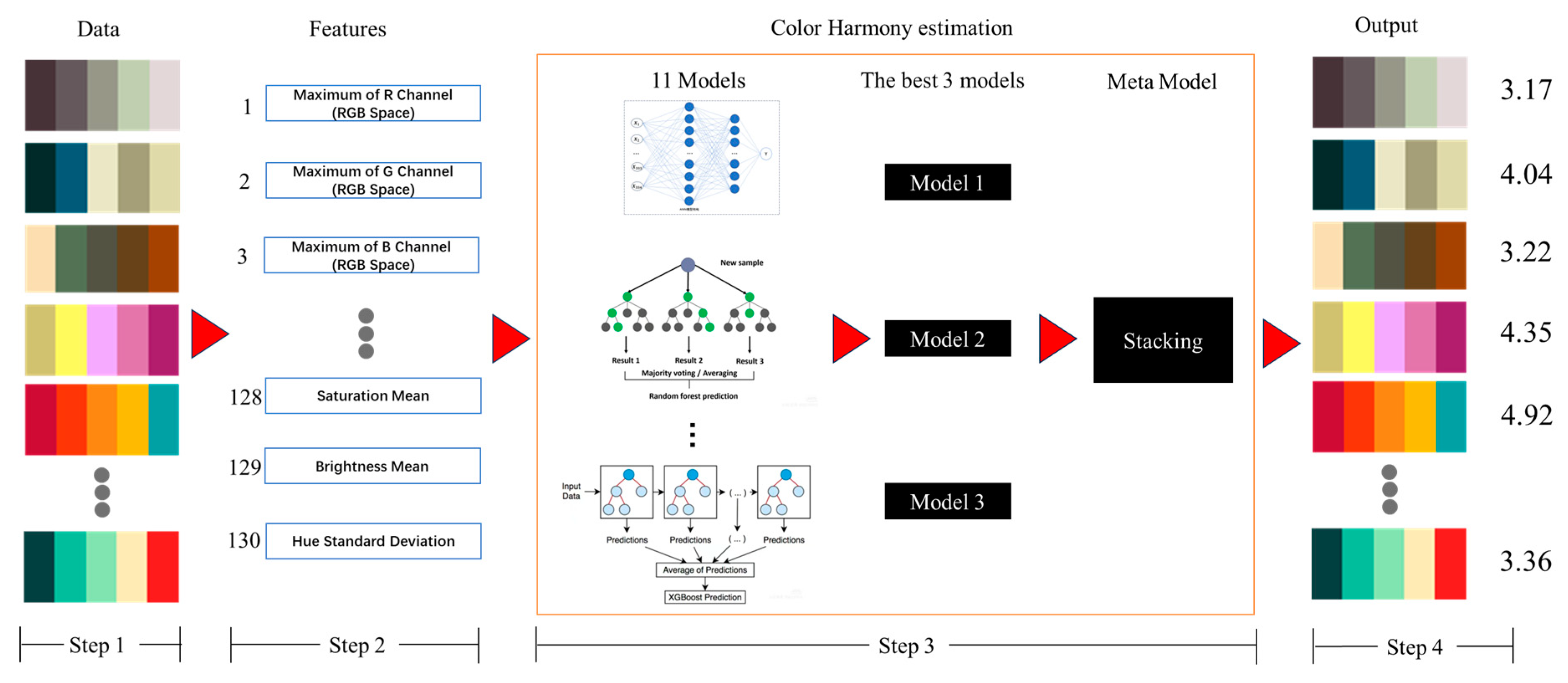
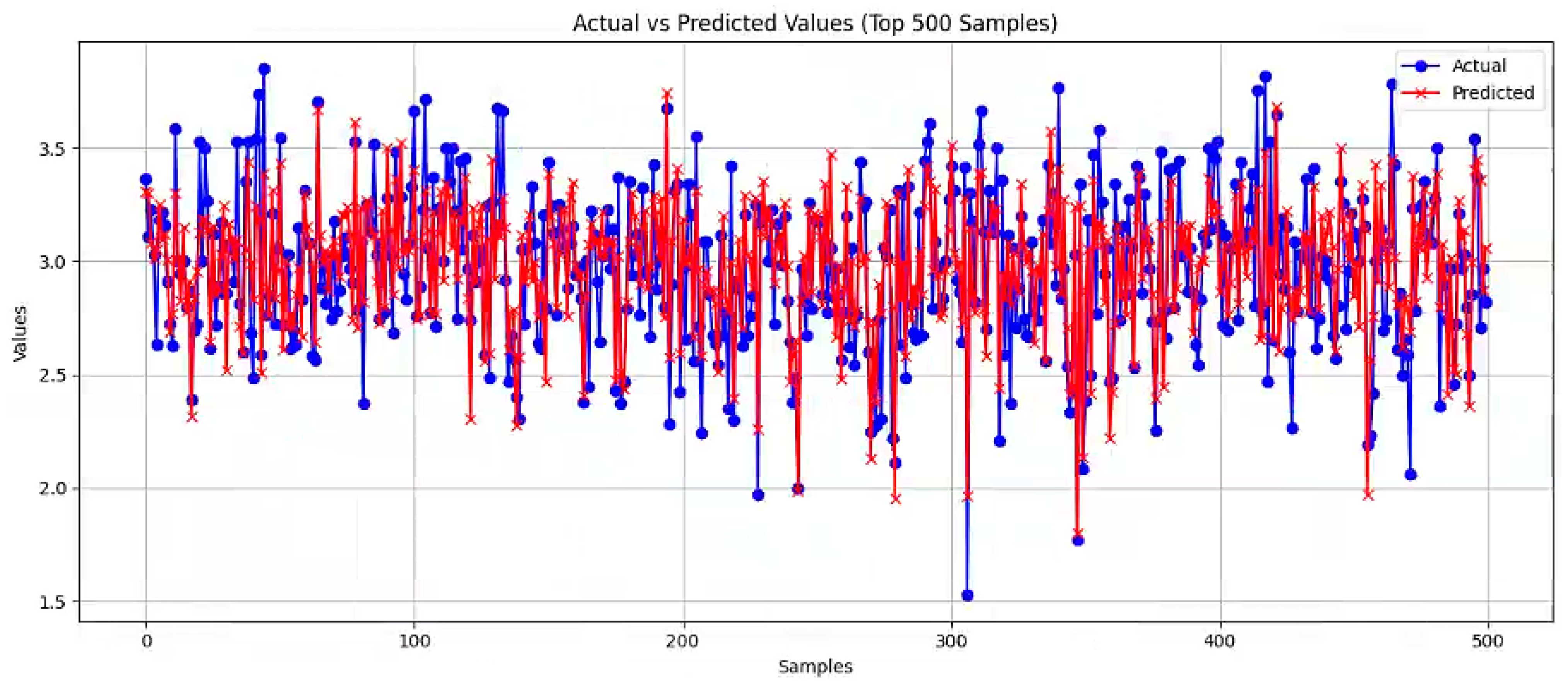

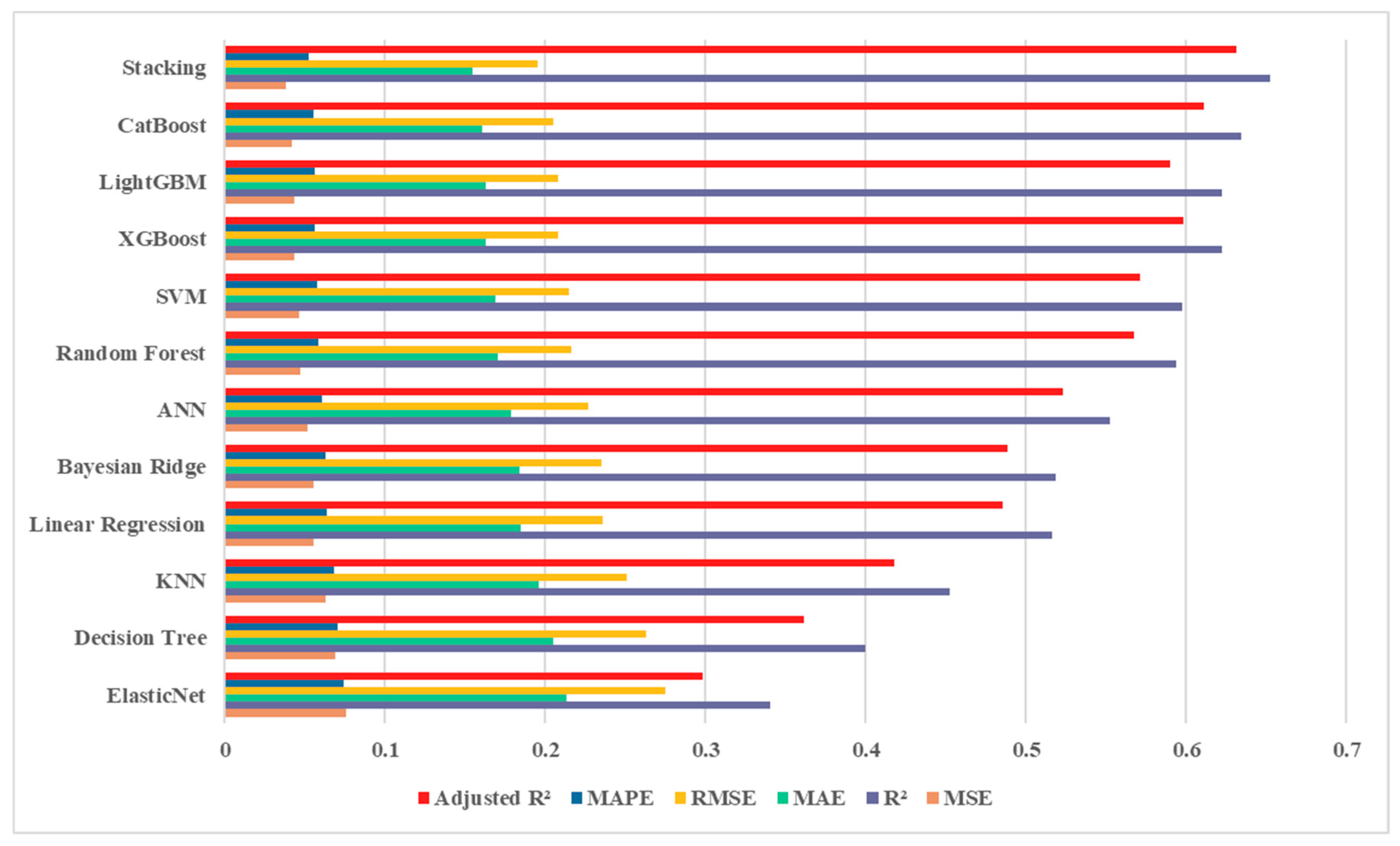
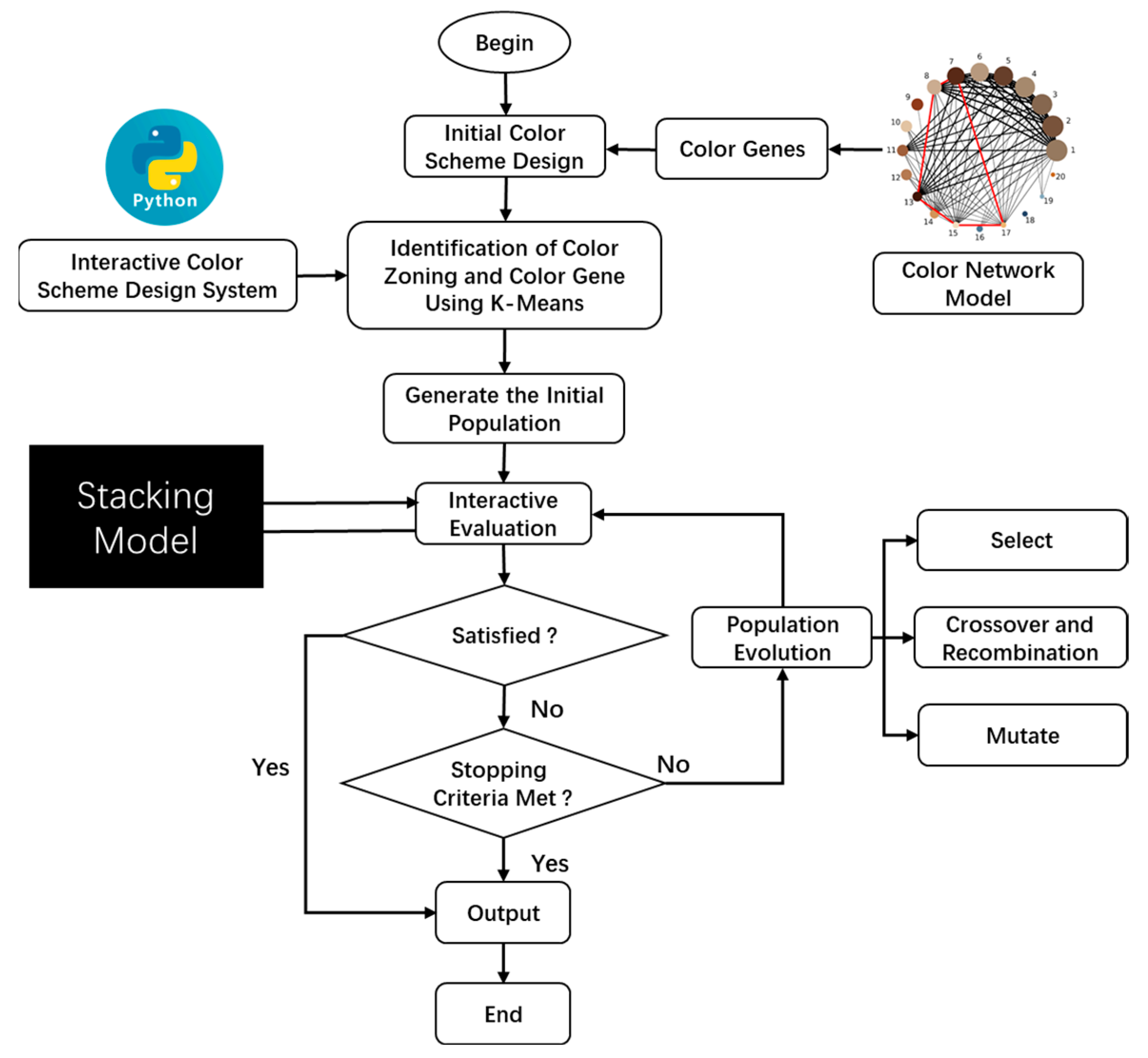
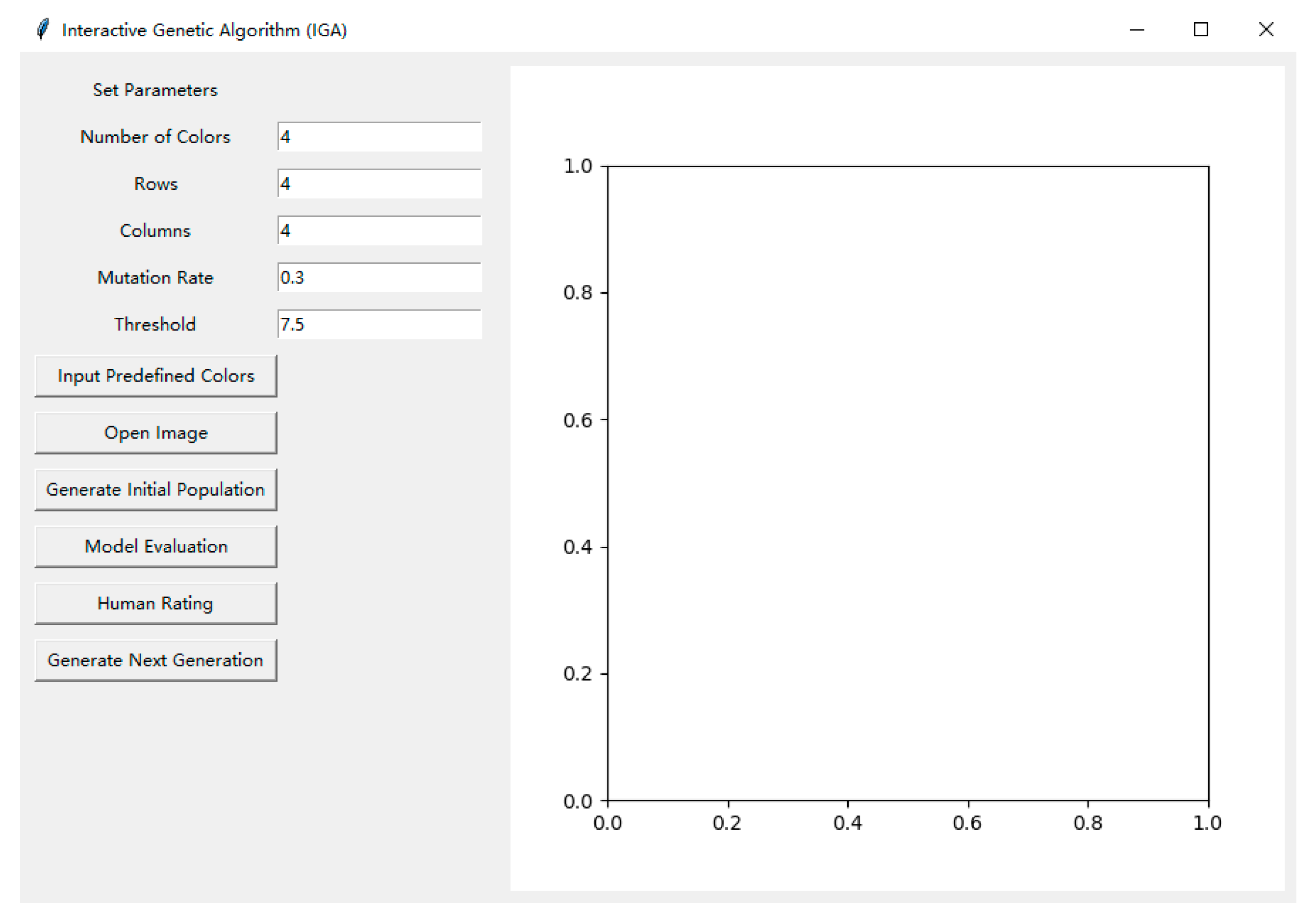









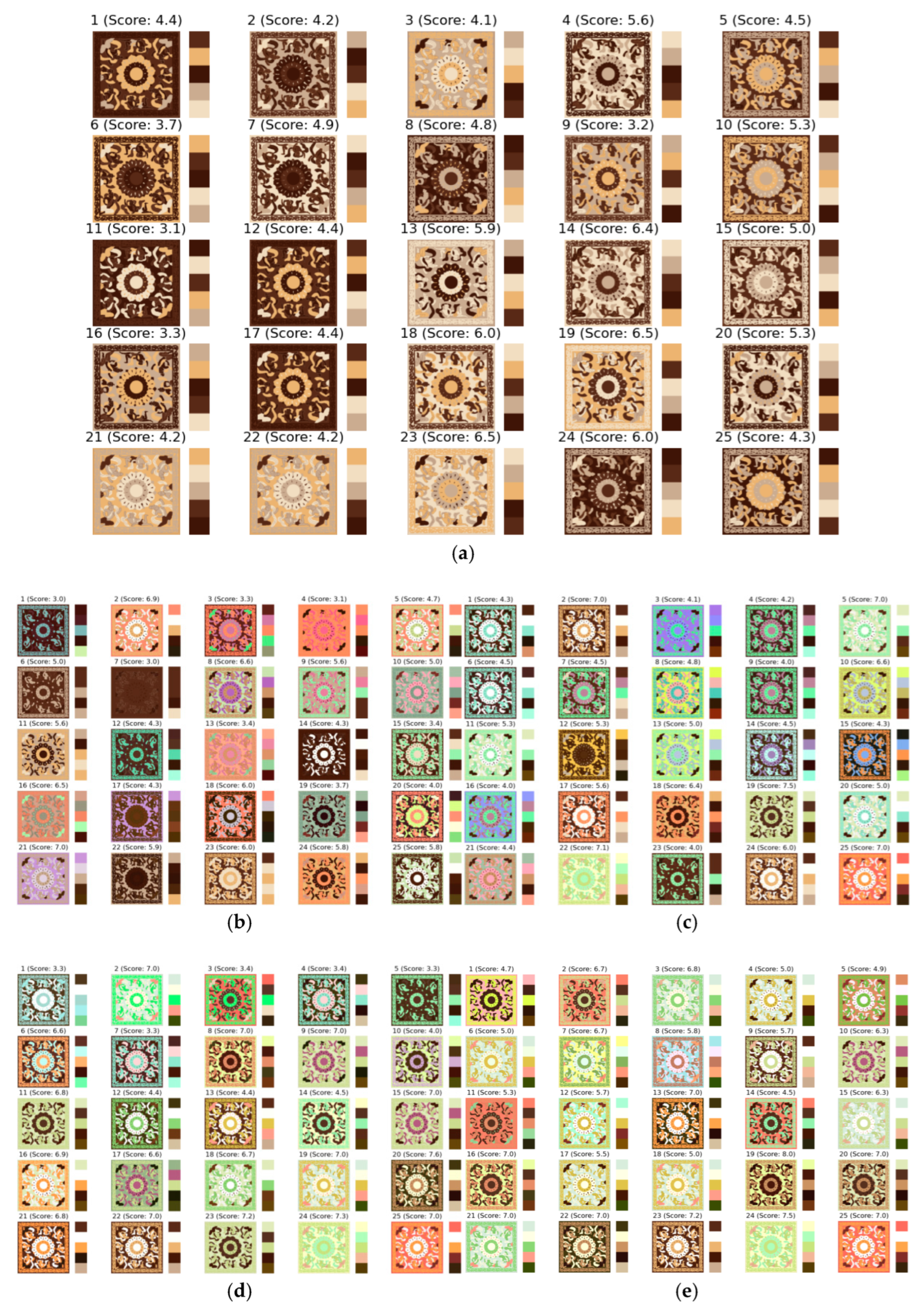
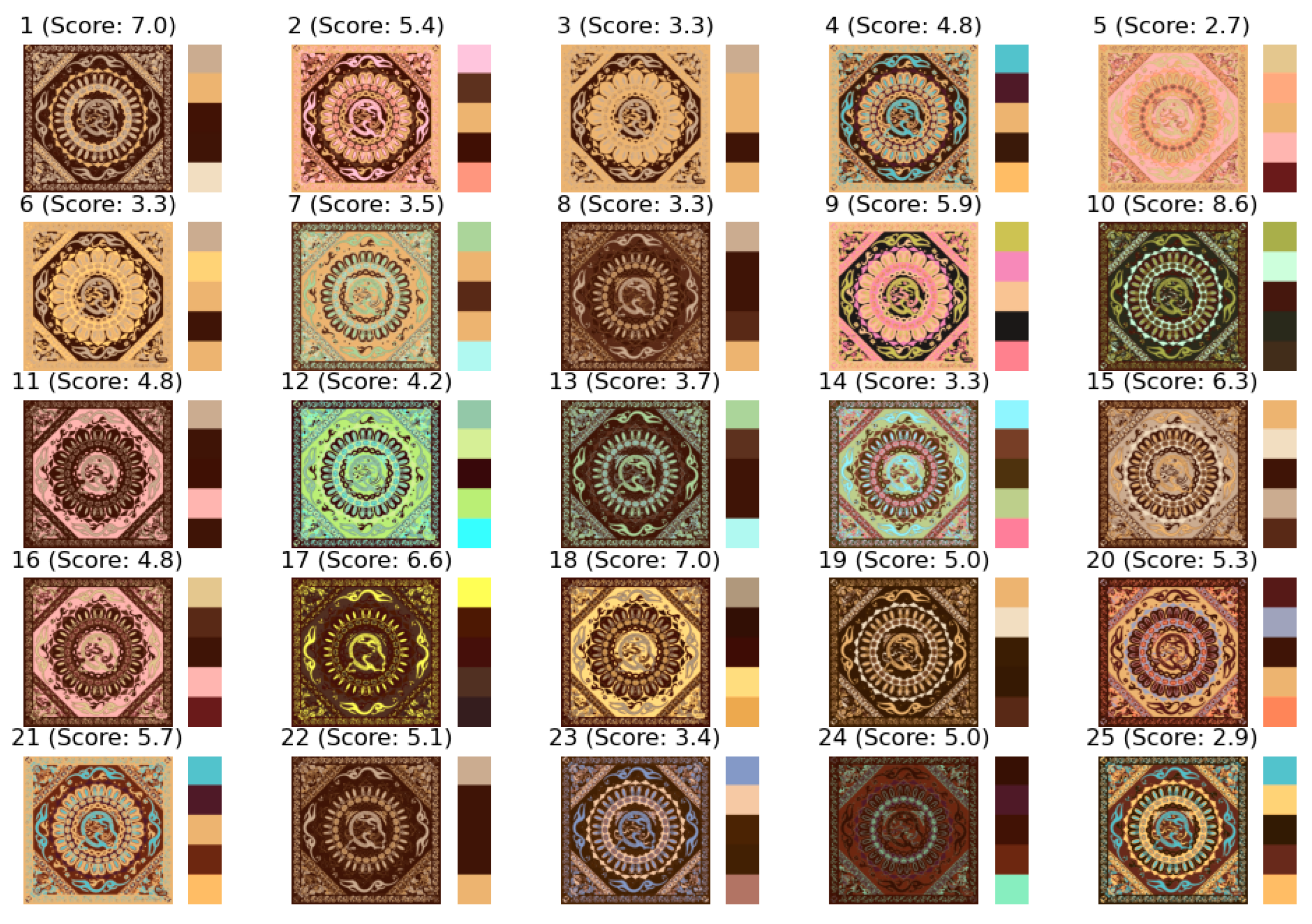
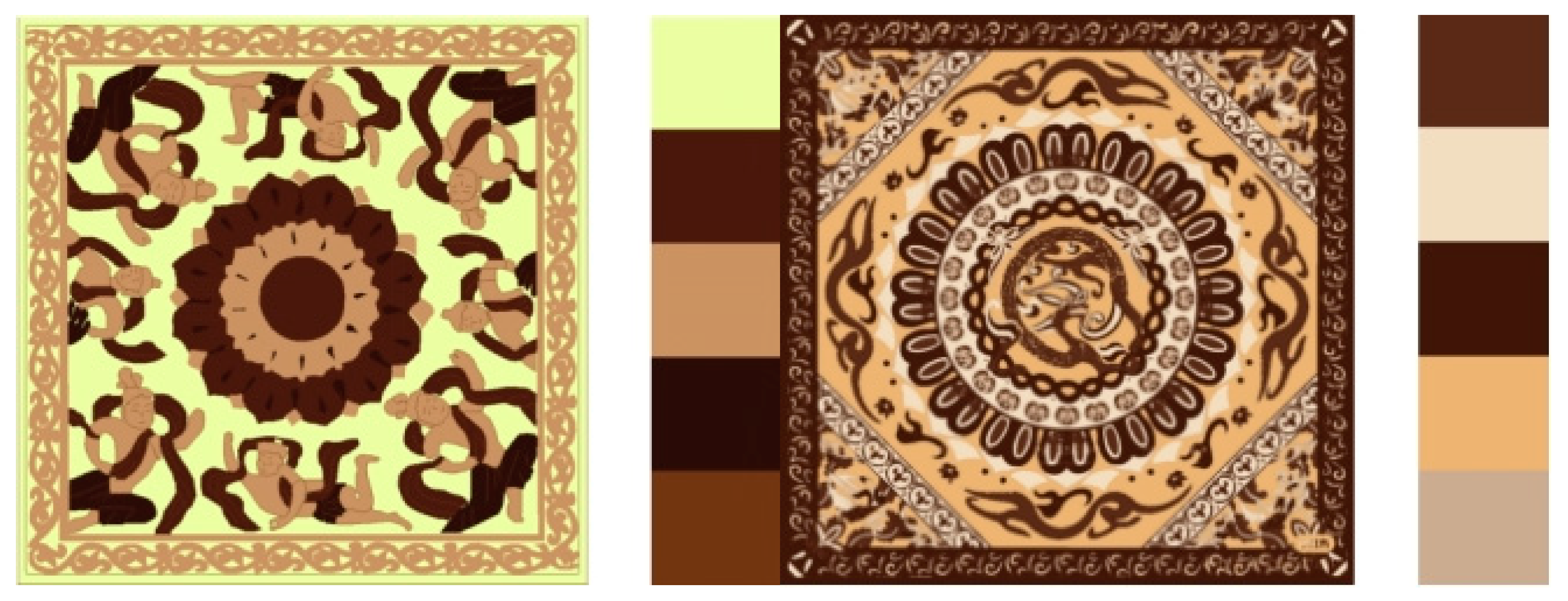
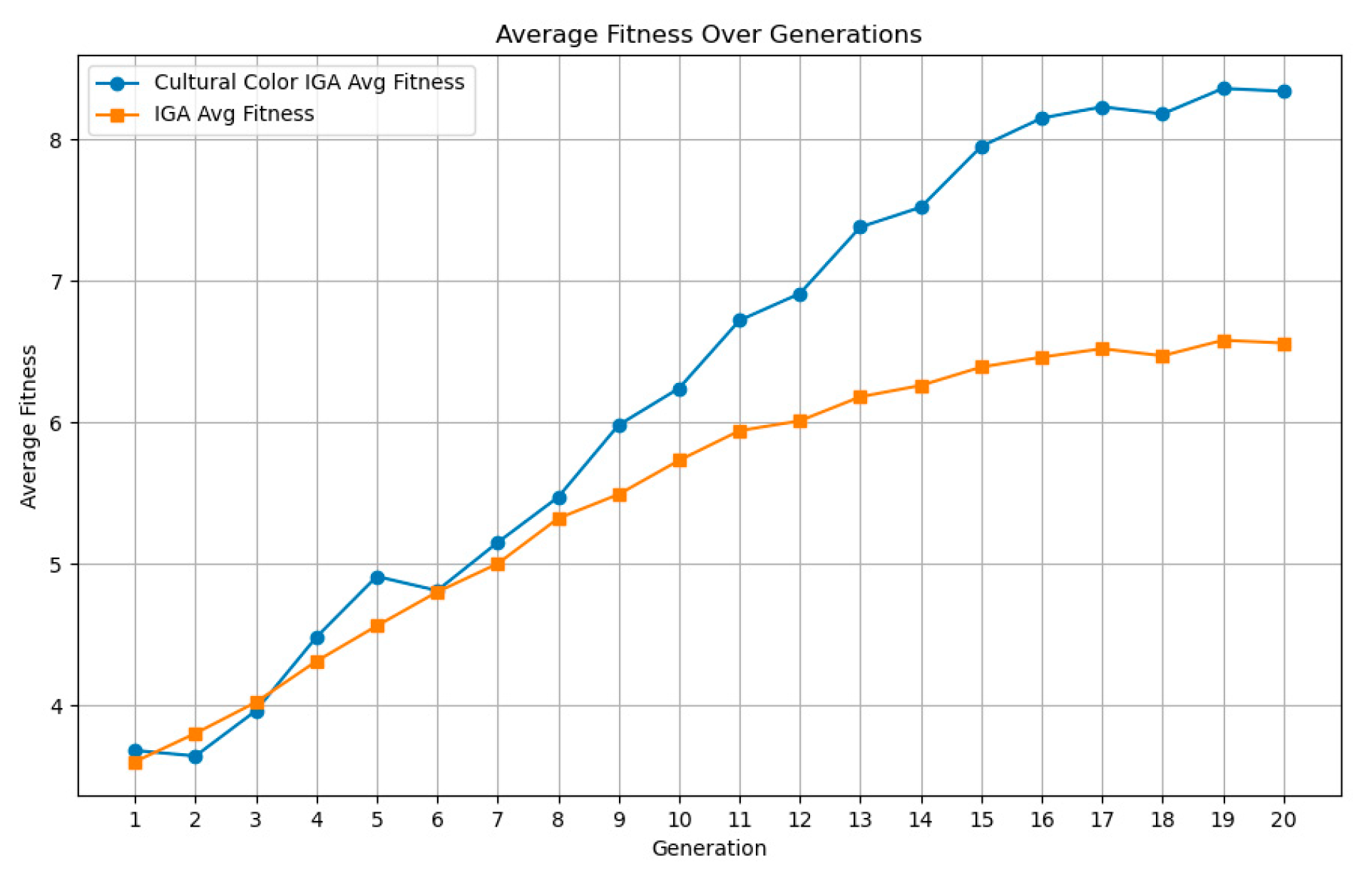
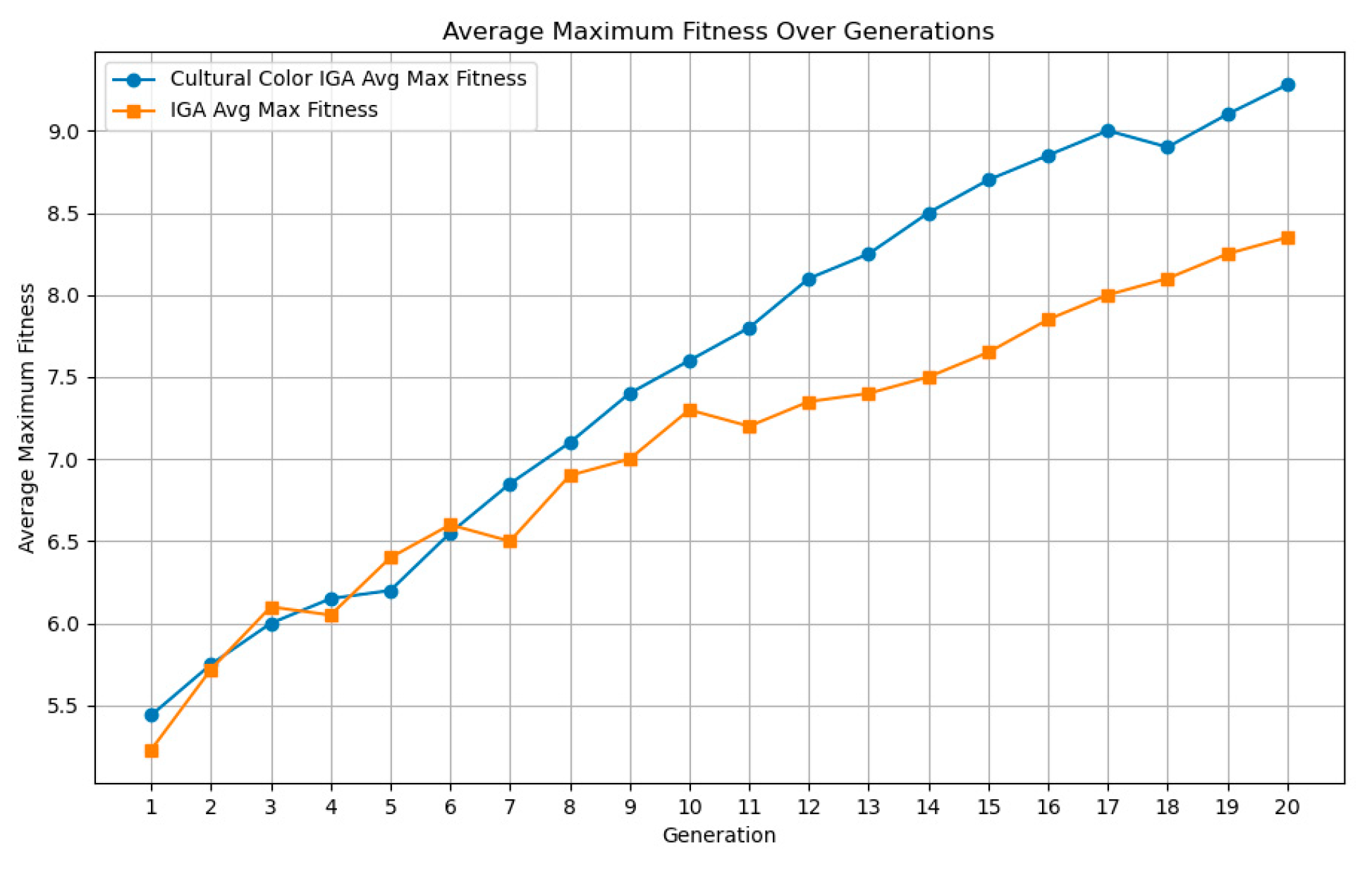
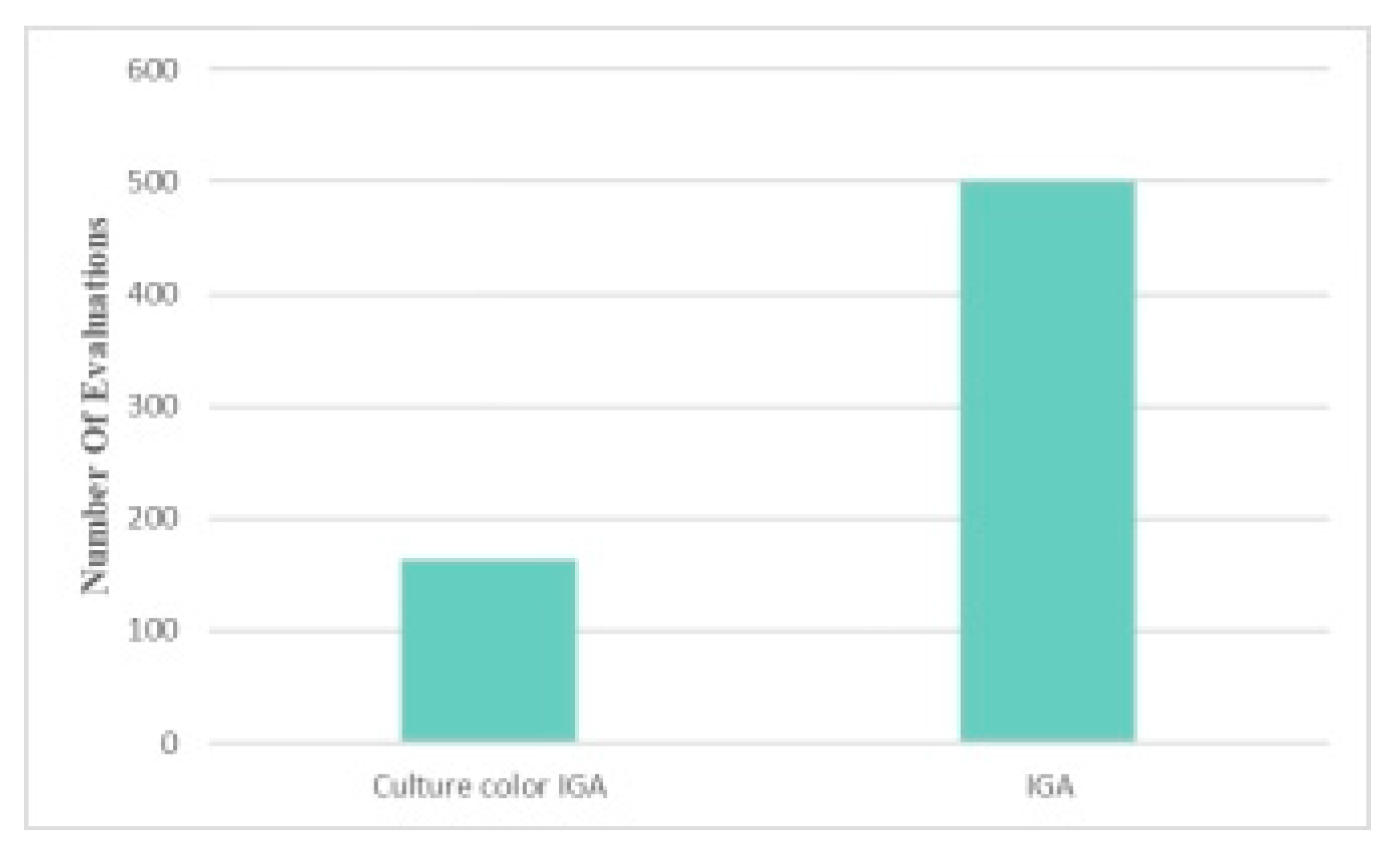
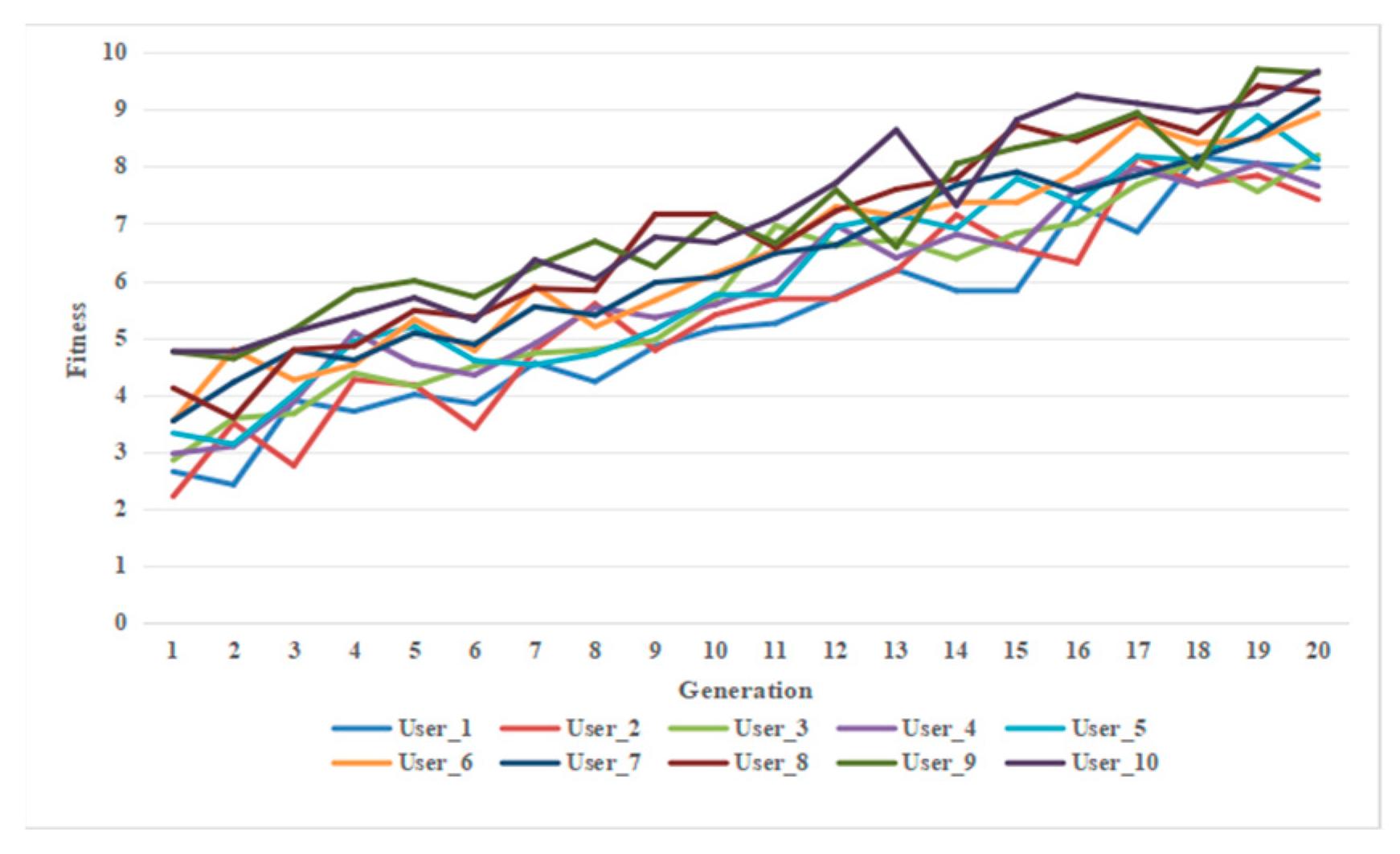
| Model | MSE | R2 | MAE | RMSE | MAPE | Adjusted R2 |
|---|---|---|---|---|---|---|
| ElasticNet | 0.0757 | 0.3401 | 0.2129 | 0.2752 | 0.074 | 0.2979 |
| Decision Tree | 0.0689 | 0.3995 | 0.205 | 0.2625 | 0.0703 | 0.3612 |
| KNN | 0.0628 | 0.4525 | 0.1962 | 0.2506 | 0.0682 | 0.4175 |
| Linear Regression | 0.0555 | 0.516 | 0.1845 | 0.2357 | 0.0633 | 0.4851 |
| Bayesian Ridge | 0.0552 | 0.5188 | 0.1836 | 0.235 | 0.063 | 0.4881 |
| ANN | 0.0514 | 0.552 | 0.1783 | 0.2267 | 0.0606 | 0.5233 |
| Random Forest | 0.047 | 0.594 | 0.1706 | 0.216 | 0.0584 | 0.5676 |
| SVM | 0.0462 | 0.5972 | 0.1685 | 0.215 | 0.0576 | 0.5714 |
| XGBoost | 0.043 | 0.622 | 0.1628 | 0.2082 | 0.0558 | 0.5982 |
| LightGBM | 0.0433 | 0.6224 | 0.1628 | 0.2082 | 0.0557 | 0.59 |
| CatBoost | 0.0419 | 0.634 | 0.1606 | 0.2048 | 0.055 | 0.6111 |
| Module | Function and Implementation | Key Features |
|---|---|---|
| Platform Selection | Implement color extraction, optimization, and display processes using the Python platform. | Modular development and efficient support for color optimization tasks. |
| Use of Color Reference Sources | Use images provided by designers as reference sources to extract color network model and generate initial color genes through the color network model. | Combining traditional culture with modern applications, ensuring the richness and diversity of the schemes. |
| Designer Interaction Design | The system automatically evaluates the harmony of the color schemes through machine learning models, allowing designers to adjust and select their preferred schemes, reducing workload. | Enhances efficiency, optimizes the interaction experience, and ensures optimization results. |
| Genetic Algorithm Optimization Process | The genetic algorithm gradually optimizes the color schemes through selection, crossover, and mutation operations with multiple iterations, balancing traditional aesthetics and modern innovation. | Ensures the practicality of the optimized results, making the schemes more culturally valuable and innovative. |
| Color Scheme Functionality | Color schemes are displayed intuitively, supporting designers in comparing, adjusting, and optimizing. The final optimized schemes can be directly used in actual design projects. | Quickly generates high-quality schemes, lowers the design threshold, and meets multi-level user needs. |
| 0.29 | 0.51 | 0.18 | 0.02 | 0 | |
| 0.31 | 0.47 | 0.12 | 0.06 | 0.04 | |
| 0.37 | 0.46 | 0.15 | 0.02 | 0 |
Disclaimer/Publisher’s Note: The statements, opinions and data contained in all publications are solely those of the individual author(s) and contributor(s) and not of MDPI and/or the editor(s). MDPI and/or the editor(s) disclaim responsibility for any injury to people or property resulting from any ideas, methods, instructions or products referred to in the content. |
© 2025 by the authors. Licensee MDPI, Basel, Switzerland. This article is an open access article distributed under the terms and conditions of the Creative Commons Attribution (CC BY) license (https://creativecommons.org/licenses/by/4.0/).
Share and Cite
Jiang, Z.; Xia, Q.; Wang, Z.; Zhu, K.; Su, Q.; Wang, J.; Huang, Y.; Wu, B.; Hong, Y. Cultural Heritage Color Regeneration: Interactive Genetic Algorithm Optimization Based on Color Network and Harmony Models. Appl. Sci. 2025, 15, 1720. https://doi.org/10.3390/app15041720
Jiang Z, Xia Q, Wang Z, Zhu K, Su Q, Wang J, Huang Y, Wu B, Hong Y. Cultural Heritage Color Regeneration: Interactive Genetic Algorithm Optimization Based on Color Network and Harmony Models. Applied Sciences. 2025; 15(4):1720. https://doi.org/10.3390/app15041720
Chicago/Turabian StyleJiang, Zhonghua, Qianlong Xia, Zhizhou Wang, Kaiwei Zhu, Qianyu Su, Jiajun Wang, Yirui Huang, Bo Wu, and Yan Hong. 2025. "Cultural Heritage Color Regeneration: Interactive Genetic Algorithm Optimization Based on Color Network and Harmony Models" Applied Sciences 15, no. 4: 1720. https://doi.org/10.3390/app15041720
APA StyleJiang, Z., Xia, Q., Wang, Z., Zhu, K., Su, Q., Wang, J., Huang, Y., Wu, B., & Hong, Y. (2025). Cultural Heritage Color Regeneration: Interactive Genetic Algorithm Optimization Based on Color Network and Harmony Models. Applied Sciences, 15(4), 1720. https://doi.org/10.3390/app15041720







